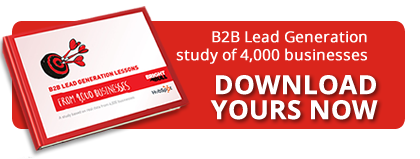 So we’ve talked about what not to do in email marketing – now let’s address the positives. There are plenty of quick and easy techniques you can employ to ensure the content you so lovingly crafted actually connects with the prospects you intended it for!
So we’ve talked about what not to do in email marketing – now let’s address the positives. There are plenty of quick and easy techniques you can employ to ensure the content you so lovingly crafted actually connects with the prospects you intended it for!
Most of your B2B prospects will receive countless messages about products and services, new content, conferences, discounts, offers, webinars etc. on a daily or possibly hourly basis (depending on how freely they share their email address). As a result, the key to increasing and sustaining your open rate is to stand out by being relevant, interesting and showing a genuine desire to help. Here are our best B2B email marketing tips to improve your metrics and ultimately win more quality leads:
1. Keep it brief
Let’s start with something simple. The optimum length for your subject line is 50 characters or less (though on mobile it can be as few as 34). Keep it concise for the most part. The only exception to this is when sending to a highly targeted list; here you can afford to go into more detail, knowing that the email is more likely to be relevant.
2. Use personalisation (sparingly)
This doesn’t necessarily have to be by name, but just means relating to the recipient in some way. Using a recipient’s entire name is more effective than first or last name if you do choose to go down that route. Reference to a location can also be appealing if your event or offer is in the same locale as that in which the recipient is based.
3. Refer to timings
Mentions of ‘last week’, ‘next week’ or ‘daily’ will ground your email in the context of the recipient’s day-to-day and imply that the content should be read within a certain timeframe. This may help to prevent your audience saving your email to read later (which generally means it gets forgotten and pushed further towards the bottom of their inbox). Time can also be used to create a sense of urgency, a technique we see used frequently in B2B event marketing. But beware of doing this too much, or using phrases like ‘last chance’, as your audience will become desensitised to it.
4. Relate to recipients
B2B subject lines should take into account your recipients' job title or function, pain points, previous contact you might have had and refer to these elements. Show them that you care and - most importantly - that you understand.
5. Take inspiration from social marketing
Treat your subject line like a tweet; try to maximise the value and return you can achieve from a very limited number of characters. Think about the tactics you regularly use to get your followers to click, re-tweet or favorite. Questions or leading statements can be effective here in creating intrigue about your enclosed content.
6. Use plain English
Tell don’t sell, explain don’t campaign, talk don’t hawk...and so on . Essentially, ensure you are in some way stating what it is the email contains, but in a creative, concise way. A salesy subject line, or one that's full of hyperbole, will largely put off prospects and doesn’t tend to indicate genuinely valuable or educational content.
(Tip: write the subject line out longhand, covering the necessary points and ignoring the length. Then cut that down to a snappier headline which is just as informative.)
7. Make use of what you know already
Take advantage of the skills you’ve honed in other areas of content marketing to shape your subject line strategy. Use specific, relevant keywords that your B2B prospects will be used to reading, which will indicate the content topic and signal that it's right for the recipient immediately.
8. Topicality
If appropriate, relate your subject line to relevant news stories or current events. Don’t make a tenuous link but rather segue smoothly into ‘What can (insert industry or sector) learn from (reference topical story or event)?’ for example.
9. Keep it simple and be realistic
We hate to say it, but if you have to think too hard about how to get people opening your email, the content may just be rubbish. If what’s inside the email is inspiring and worth sending, you should be able to come up with something that reflects that without too much difficulty. Similarly, if brevity is a struggle, you may be trying to say too much in the body of your email. If you can’t sum it up in one line, the email itself is likely to be cluttered.
10. Be interesting
Using the above tactics doesn’t have to mean stripping the subject line back completely, so don't equate simple with boring. Compiling an impactful subject line may put your creative writing skills to the test, but surely that's the reason you became a content marketer in the first place!
So you've mastered the subject line and increased your open rate, now here are few bonus ideas for your your email content:
-
Consider whether to send in text/html form only
-
Only include one call-to-action (you could repeat this same CTA, but don't try to direct recipients towards too many places)
-
Link to the CTA within the email copy as well as through a visually striking button
-
Optimise your send times based on analytics
Subject lines are very much a first impression, like an initial view of your homepage, or an introduction to a potential client at an industry event - and making a good one could seriously impact the repercussions of that point of contact. Getting your B2B prospects to open your email is half the battle, which is why we seriously recommend devoting just a little time to completing the above steps.
If you'd like to know more about how to generate high quality, qualified leads, download our ebook today.






Do you have any comments?